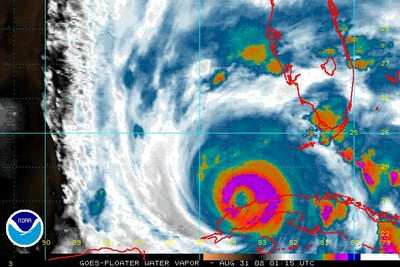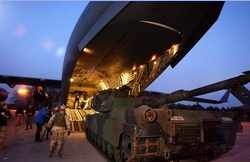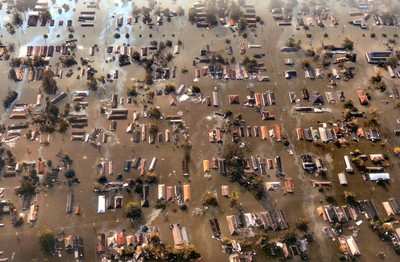Storm Weaker Than Feared, Levees Holding For Now
With Hurricane Gustav now pounding the southwestern Louisiana
coast, all preparations have been made. "Now, we pray," said an
official at the Federal Emergency Management Agency on Monday.

More than 7,000 National Guardsmen from Florida to Texas have
been called up for state missions and are patrolling New Orleans
and other cities and towns in the region. Active-duty military
personnel are standing by ready to lend a hand if needed, FEMA
officials said. US Northern Command is working closely with
civilian and state agencies along the Gulf Coast, and will provide
needed capabilities if asked.
US Transportation Command, based in Scott Air Force Base, IL
coordinated the evacuation of 16,000 "special needs" citizens out
of the affected areas. Canada sent a CC-177 Globemaster III
aircraft -- the Canadian version of the C-17 -- to help evacuate
people from Louisiana.
 Dubbed Operation Unify, the CC-177
and Canadian Forces crew flew from Canadian Forces Base in Trenton,
Ontario to Lakefront, LA to aid in the evacuation. The aircraft is
part of Canada Command -- the Canadian Forces formation responsible
for the conduct of all Canadian military routine and contingency
domestic operations in North America. The command is working
closely with its US counterpart, US Northern Command, and US
Transportation Command, as part of a whole of government approach
to ensure appropriate support.
Dubbed Operation Unify, the CC-177
and Canadian Forces crew flew from Canadian Forces Base in Trenton,
Ontario to Lakefront, LA to aid in the evacuation. The aircraft is
part of Canada Command -- the Canadian Forces formation responsible
for the conduct of all Canadian military routine and contingency
domestic operations in North America. The command is working
closely with its US counterpart, US Northern Command, and US
Transportation Command, as part of a whole of government approach
to ensure appropriate support.
Gustav made landfall near Cocodrie, LA with near
110-mile-per-hour sustained winds. Storm surge could be up to 15
feet and could challenge the levees and flood control projects to
the west and south of the city, officials said. Forecasters said
the storm is a category 2 hurricane with winds between 96 and 110
miles per hour. The winds in New Orleans should be somewhat less at
a category 1 level -- 74 to 95 miles per hour.
Once the storm moves ashore there is a chance it will breed
tornadoes and drop significant amounts of rain on an area extending
into Northern Louisiana and East Texas. Flooding is a real
possibility in those areas, officials said, though so far most
levees and floodwalls appeared to be holding.
"The Army Corps of Engineers informs me that while the levees
are stronger than they've ever been, people across the Gulf Coast,
especially in New Orleans, need to understand that in a storm of
this size there is serious risk of significant flooding," President
Bush said following an operations update at FEMA headquarters,
yesterday.
With the spector of the bungled handling of Hurricane Katrina in
2005 still looming large over federal and state agencies, President
Bush declared the states federal disaster areas well in advance of
the storm's approach to make delivering aid easier. Almost two
million people evacuated in advance of Gustav's approach, with
close to 90 percent of the population of New Orleans out of town in
time for the hurricane's arrival.

Fortunately, as of Monday afternoon it appeared the "nightmare
scenario" many had feared with Gustav's arrival hadn't come to
pass.
"The most important aspect was that people all over the Gulf
Coast took this storm seriously," said the FEMA official.
(Aero-News thanks Jim Garamone, American Forces Press
Service, for contributing to this report)
 Aero-News: Quote of the Day (04.28.25)
Aero-News: Quote of the Day (04.28.25) ANN's Daily Aero-Term (04.28.25): Decision Altitude (DA)
ANN's Daily Aero-Term (04.28.25): Decision Altitude (DA) ANN's Daily Aero-Linx (04.28.25)
ANN's Daily Aero-Linx (04.28.25) Airborne-Flight Training 04.24.25: GA Refocused, Seminole/Epic, WestJet v TFWP
Airborne-Flight Training 04.24.25: GA Refocused, Seminole/Epic, WestJet v TFWP Aero-News: Quote of the Day (04.29.25)
Aero-News: Quote of the Day (04.29.25)





